#i could write a stephen-king-sized book about the symbolism in this novel
Text
> IT by Stephen King
TW: Abuse, Sex talk, Gore, Godawful Shipping etc.
To preface this, the book is nothing like the movie. It's absolutely nothing like the movie. They took the characters' names and three isolated events from the book that were like... three pages long each, and then made a movie out of that. If you’re thinking of the movie, don't associate it with my following review, even though I’ll be using movie ss to make the review more visually appealing. I repeat, this is not about the movie.
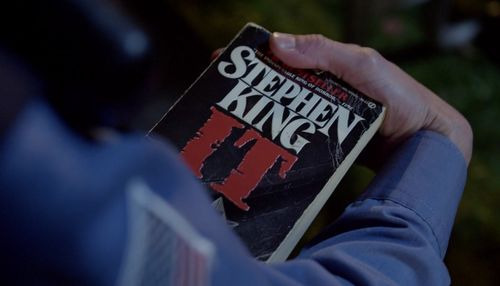
TW: abuse, sex talk, gore
IT, by Stephen King, was super crazy, I loved it, and my overactive imagination did too. the characters are so good, I'd kiss Richie Tozier on the lips in a mildly homoerotic way, the story is laid out so nicely and the word choice is insane. Sure, it might have given me nightmares about flying leeches biting dime-sized holes into my arms and flying into my mouth, but it was fun to read. Wild ride. I also liked the perspective switch, graphic detailing, and the way that these horrible events were used as a vessel to talk about philosophy. This book basically scratched all of my itches. A need for gore, a need for emotional depth, a need for comedic relief, a need for poetry, a need for murder and horrors beyond my comprehension.

Ok, I'm gonna elaborate a bit further to do the story justice. I drip-fed the book to myself slowly, reading a bit every day, five days a week, and it took me... weeks. Well, currently it's my favorite book (no other books have breached the 10-point mark yet) and there's good reason for it.
First off, the perspective switches were awesome. Point, end of the story. Incredible. I like how you were able to see everything from everyone's perspective, how there were subjective and objective accounts of things, diary entries, news articles, etc. Had me cumming and nutting I swear to god it's so good.

Second, the family dynamics were well-written. I'm a cause-and-effect type of guy, and I like when characters are fleshed out, and there's a rhyme and reason as to why they're the way they are. King (Stephen King, the author) executes this fantastically by letting you meet the families of most of the losers (that's what they call the main characters if you were unaware.)
For example, we're introduced to Bill's apathetic, cold family (giving him a motive to kill IT, since he thinks it'll make his family care about him again), we meet Eddie Kaspbraks mother, a fat, and overly emotional lady that sort of abused him (I'm pretty sure that the way she treated him was abusive) and really shaped his character from a young age. Mike Hanlon's family was awesome and supportive, real model family, but he got crap for being african american (story set in 1958, it was really bad for Mike). Richie Tozier also had a good family, Stan Uris as well (he went birdwatching a lot with his dad.) Bev's family, I think, was the worst of all because her dad physically and emotionally abused her, and well as attempting to sexually abuse her. This is later reflected in the man she marries, Tom, who physically, emotionally and sexually abuses her. It was very hard to read, I'm gonna be honest. I didn't know what it feels like to read something with a lump in your throat until I read the parts about Tom and Beverly. Plus, it's like... ultra-triggering for survivers of abuse, so I'd discourage anyone who went through that kind of stuff from reading. If you really wanna read IT though, you should skip over the Beverly POVs because frankly, they're just brutal.

Well, third, I like how Stephen King wrote sex in this book (it's a continuous theme.) And before you judge me, I'm praising him for being thorough enough, but vague enough. The story is not an erotica, it's not meant to be hot. Sex is mentioned as a form of bond, as a form of abuse (holy shit there's so much abuse in this book, it's absolutely packed with it), and also mentioned in the "losing your childhood" sort of way which becomes VERY important later in the story. Sex is only insinuated in the story, it's not graphic, you don't get any action out of it and it's only for the plot which I find awesome. Even in the part where adult Bill cheats on his wife with also-adult Beverly (lol), sex is only insinuated, even though it's the only actual erotic scene in the book.
Lastly, the poetry is crazy, and the way he strings together the literal dozens of characters with their own individual stories and experiences is so well-executed. King unironically sat down, created a masterpiece and dipped. Everything fits into place, all the experiences come together to form this... beautiful picture with no loose threads. I'm getting goosebumps and a boner thinking about this (I'm a writer, how could you tell?), but the only thing I didn't like about the book is how it ends.
(It ends with all of them moving to different states/places and forgetting each other, like, a full memory wipe, and just going back to their lives before that. They're slightly improved though, because Bev leaves her abusive husband and Ben gets a promotion, along with Bill's depression lightening up.)

Now comes something that really ruffles my feathers. I hate Ben's and Beverly's relationship. I hate, hate, hate it. If the word HATE was printed tiny, 10 times onto every square inch of the 1184 pages of the IT paperback, it wouldn't be able to touch the amount of HATE HATE HATE that I feel for the relationship between the two. Bev could have ended up with anyone else. Richie, maybe Eddie, hell, Bill would have even be fine. But Ben? Ben the weirdo who's fantasized about touching her breasts starting in fourth grade? Ben who never got over her, even as she was married? Ben who couldn't back the heck off? Ben, the lonely, fat pig who I wished had died instead of Eddie in the finale of the book? I guess he's not as bad as Tom, but holy, I was dreading the Bev&Ben arc, and it ended up being confirmed at the end of the book. Screw that, man.
Still doesn't take away from how good the book was. I'm rating it a solid ten.
#josh index#reviewposting#those who got this far#anon - you might be wondering “why didn't josh talk about the symbolism”#because that would take forever#i could write a stephen-king-sized book about the symbolism in this novel#also it would be like#viscerally personal#i'd be revealing shit about me that nobody could waterboard out of me#but yeah that's why i only talked about the book broadly#i barely scratched the surface in this review#and uh#i'm planning on keeping it this way
0 notes
Text
The Paris Review Guide to Becoming a Well-Read, Cultured, and Critically Thinking Person
Dear _________,
What kind of soulless freak could fail to answer your call? Your intelligence glows through your professed ignorance (as does the authenticity of “a very specific religious cult”). That sounds like an educationally less-than-ideal but, in other ways, fascinating childhood. My only piece of advice before recommending some titles would be: don’t fall for the inferiority/superiority racket. We’re not on a ladder here. We’re on a web. Right now you’re experiencing a desire to become more aware of and sensitive to its other strands. That feeling you’re having is culture. Whatever feeds that, go with it. And never forget that well-educated people pretend to know on average at least two-thirds more books than they’ve actually read.
A place to start is with Guy Davenport’s nonfiction collections, Every Force Evolves a Form, The Geography of the Imagination, and The Hunter Gracchus (with more pieces in The Death of Picasso). You’ll learn an enormous amount from these essays and sketches, but almost without realizing, because they give off the pleasure of great stories. Read the title essay in The Hunter Gracchus (about Kafka and the way symbols can take on a life of their own), and see if it isn’t as stimulating and creepy as the last good movie you saw.
Come up with a system of note-taking that you can use in your reading. It’s okay if it evolves. You can write in the margins, or keep a reading notebook (my preference) where you transcribe passages you like, with your own observations, and mark down the names of other, unfamiliar writers, books you’ve seen mentioned (Guy D. alone will give you a notebook full of these). Follow those notes to decide your next reading. That’s how you’ll create your own interior library. Now do that for the rest of your life and die knowing you’re still massively ignorant. (I wouldn’t trade it!)
Read My Ántonia, and then read everything else by Willa Cather. Inside her novels you’ll find it impossible to doubt that high enjoyment and extreme depth can go together. The most difficult art.
Read Isak Dinesen’s Seven Gothic Tales. I’m saying that randomly, because it seems right, and to approve the spirit of randomness.
If you get into a writer, go all the way and check out everything he/she has written. This summer I fell into a Defoe hole. Started with the major stuff, the best novels and the good journalism, and then read everything down to the poems and the tedious political pamphlets, since by that point I was equally interested in him as a human being and wanted to have as accurate a map of the inside of his brain as possible. His is one of the minds that helped shape the modern world—we’re literally still telling his stories—so there’s a vital interest. I read Maximilian Novak’s super-solid biography of him, Master of Fictions. That sort of questy reading ends up enriching your experience of each individual book and piece, and it lends a sense of adventure to the whole business, which after all involves a lot of lying down or sitting on your ass.
Borges and Denis Johnson—anything by either. Edith Wharton’s story “The Young Gentlemen.” (Random, random.) Robert Penn Warren’s All the King’s Men, and then his poems if you’re feeling spry. Find on the Web and buy an old paperback copy of the Robert Penn Warren and Albert Erskine–edited anthology Six Centuries of Great Poetry (a book for life). Read the next two things I’m going to read and then see how you like them: Grant’s Memoirs and Karl Ove Knausgaard’s My Struggle. Read Nabokov’s Speak, Memory and Joan Didion’s Slouching Towards Bethlehem.
Books that got me kick-started were the great modernist biographies, especially Hugh Kenner’s The Pound Era and Richard Ellmann’s life of James Joyce. Read those two books and you’ll have a decent-size grid on which to plot the rest of your reading. I’m somehow moved to spurt out, Stephen Greenblatt’s Will in the World. People have been writing about Shakespeare for half a millennium, and the very best of it just happened.
Ignore all of this and read the next cool-looking book you see lying around. It’s not the where-you-start so much as the that-you-don’t-stop. I was reading Phoenix Force novels until I was like thirteen. These days a lot of people I know are into Murakami. I should have said more novels. If it’s by a Russian, read it.
0 notes
Text
Imaginary Friend Book Review
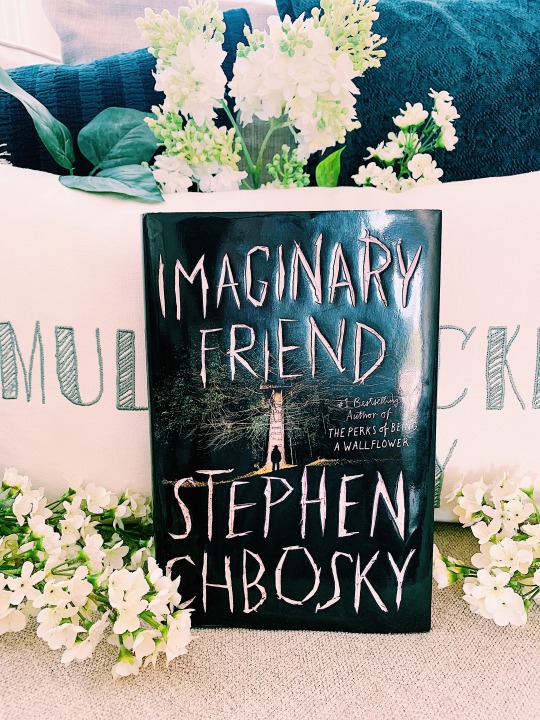
Imaginary Friend by Stephen Chbosky Book Review
This is undoubtedly the weirdest book I have ever read.
You might be thinking… but, thetypedwriter you read fanfiction! This can’t be the weirdest thing you’ve ever read! Things like ABO universes exist!
You would think that, wouldn’t you?
But no.
I shall endeavor to give you a spoiler free synopsis of the book first followed by my thoughts and criticism, but note that this is an endeavor for a reason. I have now explained this novel in depth to two different people, and both times I have found myself completely and irrevocably stuck on how to even begin, let alone end.
With that forewarning, here we go.
The novel surrounds a single mother and her young son moving to a small Pennsylvania town in order to escape the tragedies of their past that include the passing of her husband and her current abusive boyfriend.
However, while things in their new home start out well-they find solutions to unemployment, poverty, the son’s dyslexia, etc, things start to go awry when Christopher, the son, is lured into the Mission Street Woods at the edge of town by a voice only he seems to be able to hear.
As Christopher continues to listen to the voice in the form of a cloud, or a plastic bag, or even inside of his mind, he starts recruiting his friends to build a treehouse in the woods that will transport him to a different time and place.
The voice, lovingly called the Nice Man, instructs him to finish the tree house by Christmas Day.
Or else everyone will die.
As Christopher struggles with newfound powers and responsibilities, coping with two different worlds, his mother struggles with her son’s sanity, the town struggles with anger, blame, and temptation, and what follows is the chaotic descent of a small town into the throes of good versus evil, love and loss, and most importantly, trying to differentiate what is real versus what is imaginary.
In the simplest terms possible (a facetious statement if there ever was one), I thought this was going to be a thriller mystery book about a single mother and her young seven-year-old son Christopher leaving their home and her abhorrent abusive boyfriend in order to start a new life with hope and potential.
And it….is?
But it doesn’t stop there. Chbosky crams so many genres, themes, motifs, and messages into this book that when you think about it, it’s unsurprising that it’s over 700 pages long with the tiniest, most miniscule font I have ever had to squint at.
However, make no mistakes like I did, this book is horror.
Yup. You read that right folks, horror.
To preface, and I might have mentioned this in another post for another book at some point, but I vehemently dislike horror of any kind. This extends to books, movies, shows, etc.
I understand that horror is a great joy and pleasure for a vast amount of people and that it contains its own literary merit, tropes, and rules, and I can appreciate that for what it is from afar, but I personally take very little enjoyment from consuming anything horror related (I apologize to all the Stephen King fans out there in the world).
I did not fully realize the extent to which this book was a true horror.
This is entirely my own fault. I was very much blinded by the rosy colored glasses from college when I first read The Perks of Being a Wallflower, Chbosky’s first and only other novel.
Perks is wonderful. It is a tragic, yet fundamentally hopeful and loving bildungsroman that shows the beauty and the pain of growing up and accepting yourself. The movie with Emma Watson is what dreams are made of.
I committed author fraud when I picked up Imaginary Friend based on the pure speculation that I would most likely like it since he had written Perks, a book I adored as both a reader and a teacher.
I’ve warned readers against this in the past, but it seems like I should have taken my own advice: just because an author has written one good book or one book you like, does not automatically mean you will like their second book, or any of their other books for that matter.
This cannot possibly ring more true for Stephen Chbosky, as not only are his two books completely different in narrative and structure, but also vastly different in genre and purpose.
I should have stuck with my gut and realized that I probably wouldn’t like this book based off the synopsis, the genre, and yes, even the cover (it looks scary to me, okay?), but I said noooooo, it’s Chbosky, you have to read it!
And this is where we ended up.
First of all, I didn’t hate the book.
I can recognize that it is extremely well written, well crafted, and well developed. I can enjoy a slew of characters, and oh boy are there a multitude to pick from, and I can give credit where credit is due.
Chbosky is a talented writer. There is no doubt in my mind about this. The way he crafts words, the way he plays with texture and space, and with fonts and sizes, is nothing less of sheer brilliance.
He undoubtedly is also masterful at motifs, foreshadowing, and symbolism. Notably, there were so many recurring objects, colors, metaphors, and so on that were sprinkled out so consecutively and intentionally throughout the novel-some I didn’t even pick up until the end-that I was left reeling from how immensely talented and brilliant he is.
Things like his use of baby teeth, blue moon, and fogs/clouds/mist struck me in particular. I know this seems like gibberish, but Chbosky truly came across as understanding what he wanted to portray and how he wanted to deliver it.
However, the biggest compliment I can give to Chbosky is the sheer magnitude of his imagination and creativity. This book almost overwhelmed me through the use of ideas and concepts I had never really thought of before.
Alternate dimensions? Check.
Supernatural powers? Check.
Incredible use of diction and figurative language? Check and check.
Chbosky had so many wild and tantalizing beautiful turns of phrases, expressions, and descriptions that it left me with the same sort of gasping epiphany that Maggie Steifvater’s writing always leaves me with, the feelings that writing can be so utterly beautiful and compelling, that it can be all-consuming as well as never ending with its potential to stun, to create, and to warp to unique needs and purposes.
It definitely was a reading experience quite like any other I’ve had.
Be that because of the horror genre or because of Chbosky’s odd, yet addicting writing style and this has definitely become a book that left me more than a bit dumbfounded. Although I’ve sung its praises and admitted to my own faults at this point, this book isn’t without flaws.
To me the horror genre itself is just not my cup of tea like I’ve stated. Strike number one.
Second, the book was...abysmally long. Atrociously long. As I’ve also said before, I do not mind large books. In fact, big books when you’re reading something you love is a true blessing. Finding that fanfiction at 3am that hooks you immediately and you look up to see its 300k? Amazing.
Starting a new book series that you fall in love with body and soul and realize you have several installments left in the series to gorge and devour? Ecstasy.
Sloughing through a single book that starts to drag on and on repetitiously for what seems like forever? Borderline hell.
This book could have been 300 pages shorter and still contained everything Chbosky wanted to accomplish. It could have had the same brilliant writing, messages, and motifs, but without all of the never-ending back and forth between worlds and battles that just kept popping up time and time again. The abominable length considering its content is strike two.
Last, the ending was a bit of a cluster. At this point in the novel, so much is going on, you are being exposed to so many pov’s that it’s almost stress-inducing, and events taking place are cataclysmic and 10/10 on drama. Chbosky bit off more than he could chew here.
The book choked itself at the end, which, after reading for 700 pages is not the feeling you want to have. The ending left me befuddled, disappointed, and also bereft of a conclusive end and explanation for the shitstorm that had just rained down. It was not the ending I wanted, could understand, or could even really grasp. Strike three.
This book has a plethora of merits followed by three enormous criticisms. If you like horror, then you’ve already crossed hurdle number one. If you can accept it’s repellant length (let alone have days upon days of free time to actually ingest said behemoth) then that’s hurdle number two.
Hurdle three is up to you. Perhaps you would like the ending where as I found it lacking in structure, content, and answers. I like my endings tied up with neat little bows. I don’t like to be left thinking...hmmmm what does this mean?
If I am going to read your massive book, I deserve an ending that satisfies the journey. Authors telling readers that it’s up for interpretation makes me want to strangle something. It comes across as enormously pretentious to me and oftentimes lazy.
In the case of Chbosky, I think he had given himself so many loose threads that the neat little bow I desired was next to impossible.
So he didn’t even try.
Score: 6/10
Recommendation: If you love The Shining, are lacking bouts of creativity and imagination, have lots of free time during Quarantine, and don’t mind having an Inception-esque ending where you might not get all the answers you want, while being tasked with concocting it for yourself, Imaginary Friend might be your new best friend.
Bonus: Here’s a pic of my kitty photo bombing this book shoot. Hope she brightens your day!
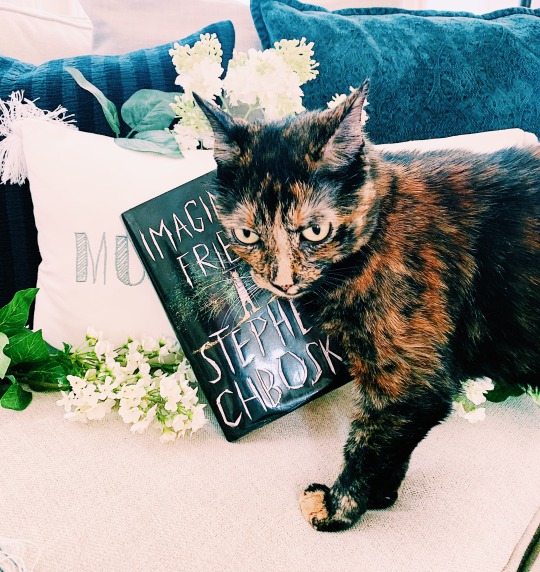
#imaginary friend#stephen chbosky#perks of being a wallflower#horror#horror book#stephen king#the shining#literature#books#book blog#book review#book rec#Book Recommendations#book reflection#book analysis#popular fiction#top books#booklover#book
72 notes
·
View notes
Text
D-Views: The Hunchback of Notre Dame
Bonjour, mes amies! Welcome, bienvenue, to another installment of D-Views, my written review series for films produced or inspired by the Walt Disney company! For more reviews for films like Enchanted, Star Wars Episode III, and Snow White and the Seven Dwarfs, feel free to consult my “Disney reviews” tag, and please, if you enjoy this review or any of the others, please consider liking and reblogging! I look forward to writing more of these in the future for films like Wreck-It Ralph and Halloweentown, as well as Non-Disney films like Charlotte’s Web.
I recently put out a poll suggesting three Disney Renaissance films for possible review subjects, and although The Little Mermaid won that poll, this film ended up not far behind. (Thank you, @schifty-al and @mygeekcorner for your votes!) It’s one of my personal favorite Disney films of all time...The Hunchback of Notre Dame!

Victor Hugo’s classic novel Notre Dame du Paris, called The Hunchback of Notre Dame in English, seems like a very odd inspiration for a Disney animated family film, and that’s because...yeah, it is! When the Disney animators first brought Hunchback to the table, they were less inspired by the original Hugo novel glamorizing the architecture of Notre Dame cathedral, and more inspired by a graphic novel adaptation of the story, which was likewise much more influenced by the 1939 Hollywood film adaptation. Because of the historical context that 1939 adaptation was made in (premiering at Cannes during the rise of the Third Reich), themes of social justice were added to a story that originally was about how the “edifice” can outlast the flaws and sins of mankind. The “social justice” element is something that Hugo interestingly put more in his follow-up to Notre Dame du Paris, the epic brick book Les Miserables, but has since been similarly tied in the public consciousness to The Hunchback of Notre Dame, despite not existing in the original book.
The project was already an odd choice for Disney to take on thanks to the darkness of the book, but the political themes also were unique for a Disney picture as well. It clearly was a more “adult” endeavor, even though thanks to the success of previous projects like Aladdin and The Lion King, there were studio mandates demanding more comic relief, and even the marketing team was reluctant to advertise Hunchback as anything other than a family film. Rather than showing the artistry and darker scenes, the marketing almost entirely focused on the Feast of Fools and the gargoyles, highlighting the “Ugly Duckling” aspect added to the story and downplaying the more adult themes. In the end, it’s likely thanks to those poor marketing choices and the inconsistent tone of the picture that this movie failed to find its audience on first run. It only earned $21 million worldwide, compared to Pocahontas’s $29 million and The Little Mermaid’s $84 million, with mixed critical and audience reaction. Although it was nominated for an Academy Award for its music and won several others, it was noticeably less successful than other installments in the Disney Renaissance, and even now, Disney often doesn’t give Hunchback that much attention. Like Quasimodo, the film has been sort of locked up in its own tower...but now, today, I aim to bring The Hunchback of Notre Dame out of the shadows and give it the appreciation it deserves.
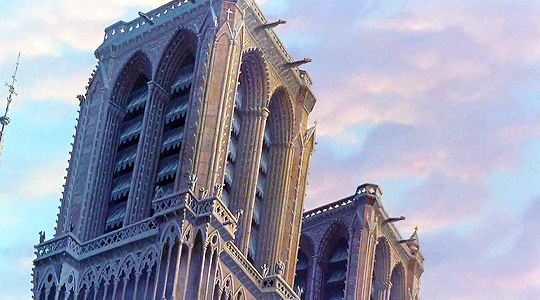
Our film begins in complete darkness, accompanied by resounding church bells and the amazing vocalizations of the English Opera Company, and from the very beginning, I’m just enveloped by the embrace of Alan Menken and Stephen Schwartz’s unbelievable score. Choral music in general has always been something special in my family. My mum and dad were in choirs a lot of their lives: they even first met when they joined the San Diego Master Chorale in the 80′s. Choral music remains one of my mother’s greatest loves and passions, and when I saw Hunchback, it made the choral music my parents loved so much, which focused around a faith I hadn’t been raised with and didn’t believe in, that bit more accessible to me as a child. Mum, who studied Latin in college, went on to teach me about all of the chants and phrases Menken and Schwartz added to each song so that I could more appropriately sing along. It remains one of those Disney soundtracks that cemented our close bond, and I’ll always treasure being able to see the La Jolla Playhouse production of The Hunchback of Notre Dame with my mum and getting to hear the amazing choir and instruments live.
The Bells of Notre Dame, as an opening number, cannot be matched in how it introduces us all to the story, characters, themes, and tone of the piece. In just a few minutes, the music and lyrics perfectly showcases our setting, the theme of what makes a man, the atmosphere of fear and injustice, our villain, and our hero. Menken and Schwartz previously worked together on Pocahontas, but Hunchback in my opinion easily outstrips their previous collaboration. The use of church bells of all sizes to convey the solemnity, mystery, and grandeur of the cathedral at the center of the proceedings, and the clever use of Latin phrases -- it’s just unbelievable! As one example, in the sequence where Frollo (a judge in this version, as opposed to the Archdeacon) chases Quasimodo’s mother up to the stairs of Notre Dame and she pounds on the door, crying for help, the choir sings “Quantus tremor est futurus quando Judex est venturus,” which means, “What trembling is to be when the Judge comes.” And sure enough, the line comes to a horrible, horrified halt when Judge Frollo snatches the woman’s child away and throws her to the ground.
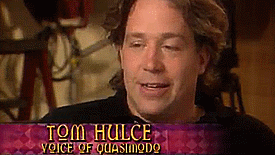
After one of the most epic musical introductions in a Disney film, we meet our sweet, gentle hero, Quasimodo, voiced by Tom Hulce, who is just such a ray of sunshine. Although I loved hearing Michael Arden as Quasimodo on stage, Tom Hulce will always be my Quasimodo. When I was a teenager, I went through a horrible “hating the world” phase where I only ever saw pain and suffering and felt not only powerless to make anything better, but worthless as well. During that time, I turned my back on a lot of the things that had brought me joy, feeling almost unable to enjoy them anymore. One of the very few exceptions, however, was this movie and especially the character of Quasimodo. When I was at my darkest points, Quasimodo never failed to bring me some light, not because he was particularly funny, but because for all of the misery in his circumstances, he never faltered in being gentle, creative, and kind. Looking back on how I’d been, I wish I’d had just a shred of Quasimodo’s grace back then. I wish I hadn’t allowed myself to fall into despair and resentment. Since I can’t go back, however, I keep Quasimodo in my mind sometimes whenever I’m going through something difficult. He’s kind of become a guardian angel of sorts to me, reminding me that my life is a precious gift and I shouldn’t take anything for granted. And really, I couldn’t do that if not for Tom Hulce and Quasimodo’s supervising animator, James Baxter. I truly am grateful to both of them for giving me a character that even now can be a symbol of everything I wish I could be.
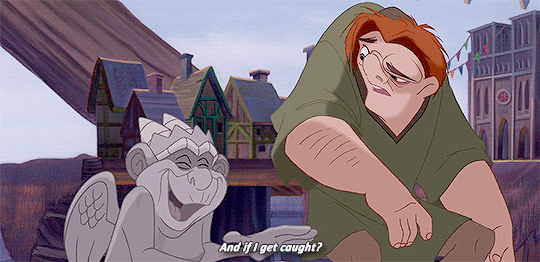
Unfortunately along with Quasimodo, we also meet the gargoyles, Hugo, Victor, and Laverne. As a kid, I actually liked the gargoyles all right, but as an adult...yeah, they really break the mood. Badly. The worst offender is easily Hugo, which is a shame because I like Jason Alexander as a performer, but he just goes way too over-the-top-obnoxious. It would admittedly not be as bad if it were clear that the gargoyles were all in Quasimodo’s head, but Djali sees Hugo come to life at one point and they later help Quasimodo fight off the guards. I greatly prefer the way the gargoyles are handled in the stage production, where all of the saintly statues have their own voices that nonetheless reflect what Quasimodo is thinking and when Quasimodo hits his lowest point before Esmeralda’s execution, he forcefully banishes them out of his head.
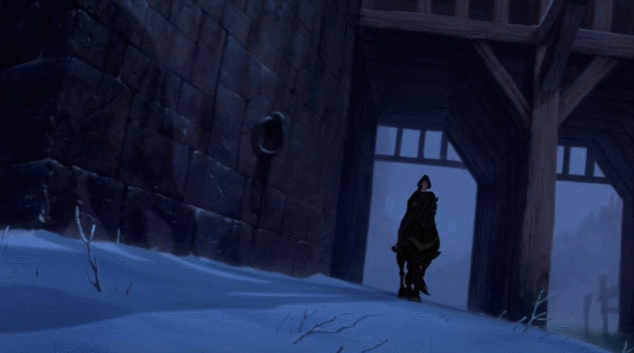
Even though the comic relief is handled poorly, I certainly cannot say the same for the villain. Judge Claude Frollo is easily one of the most evil villains in Disney history. Tony Jay’s vocal performance is just chillingly resonant, commanding your attention and making you subconsciously shrink in on yourself whenever he speaks. It makes for a despicable, cold, cruel man -- the antithesis of a father, the true embodiment of a monster. Frollo is often compared to Mother Gothel from Tangled in how they both lie to, control, and emotionally abuse their charges (Quasimodo and Rapunzel, respectively), but I personally find Frollo so much worse than Gothel, because he not only cuts Quasimodo off from everyone, but he indoctrinates a gentle, kind soul like Quasimodo in his racism and intolerance against those different from him -- including Quasimodo’s own people, the Romani. Mother Gothel hoards Rapunzel away like a dragon hoarding treasure -- Frollo treats Quasimodo like a burden, beating into him that no one else would want him and that Frollo was such a “good man” to take him in. It’s just vile.

And now we come to my single favorite Disney song of all time -- Quasimodo’s aria, Out There. From the time I was little, this song spoke to me like few others did. Growing up, I was an only child with a huge imagination surrounded almost entirely by adults and who had a lot of difficulty relating to kids my age. I often liked being on my own, but it didn’t change how I often felt different and detached from the people around me, and as I got older, that feeling only increased. I moved a lot in my childhood, making it difficult for me to plant roots, and I rarely followed trends or popular norms, so I constantly stayed in the fringes of the crowd, enviously looking on at those who could fit in more easily than I could. I always tried to hide my insecurities, but they were still there, and when those insecurities took hold, I would often imagine the world being a place where I could be myself, just like Quasi does. Quasimodo’s longing to be “part of them” and lamentation of people being “heedless of the gift it is to be them” has always resonated with me, and even though it’s hard for me to sing Out There without shifting octaves, my heart swells every time I hear it.
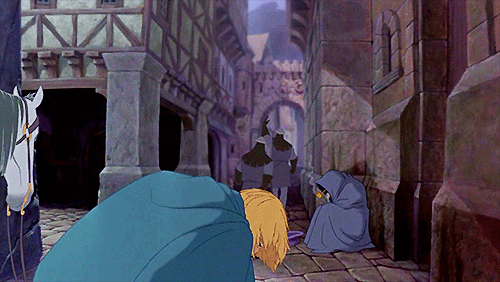
The Captain of the Guard, Phoebus, is easily the biggest liberty that Hunchback adaptations have made with the original novel. The book version of Phoebus was more like Gaston from Beauty and the Beast than how he’s portrayed here, but I frankly have no complaints. Kevin Kline is wonderfully dry and witty in the role -- he’s more than a match for Esmeralda, being brave, noble, and sarcastic with seemingly no prejudice for those different from him. And then yeah, as for Esmeralda herself...as Phoebus says later, “what a woman!” Esmeralda was one of my very favorite Disney heroines as a kid, and she still is. The character of Esmeralda is often rather saint-like in her incarnations, but here we see both the “angelic” and “demonic” sides of her -- she’s fiery, but kind; rebellious, yet noble; anti-authority, but patient; distrustful, yet loyal. In the musical adaptation, when Esmeralda is first revealed, we hear Frollo, Phoebus, and Quasimodo sing this about her --
Frollo: She dances like the Devil!
Phoebus: She dances like an angel --
Quasimodo: An angel!
Phoebus: -- but with such fire!
Frollo: Such fire!
All Three: Who is she?

This is Esmeralda’s characterization and her relationship to the three male main characters in a nutshell. Quasimodo only sees the best of Esmeralda; Frollo only sees the worst of her; and Phoebus sees her for everything she is...as a person. And this is why she ultimately chooses Phoebus, unlike in the book where she solely chooses Phoebus because of his looks.
When we reach the Palace of Justice, I’m reminded that I have yet to accent how absolutely stunning every single background is in this movie. Yes, the animation overall is wonderful, whether in the character animation or otherwise, but there are few Disney films that have more atmospheric and beautiful backgrounds than this. It serves to give the movie such a wonderful depth and makes the setting feel that much richer and deeper. Admittedly one weaker aspect of the animation is the now-slightly-outdated CG background characters. They were made by taking a handful of templates and then mixing up their clothes and colors, so as to multiply them ad infinitum and make the crowds of Paris look bigger and more colorful. Even with that, though, you do sort of have to look carefully at the background crowds to notice, as there are lots of hand-drawn characters sprinkled in in front of those CG models that help obscure their repetition and awkwardness. Those CG crowds also make the city of Paris look appropriately overcrowded and huge, so I’m glad that they used the technology even if it was still so in-progress at the time.
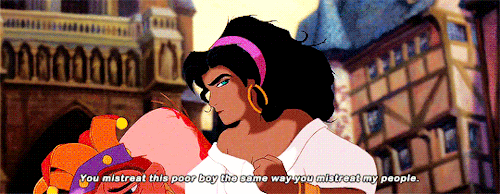
Even though Topsy Turvy starts off so fun and festive, however, it soon devolves into a terrible riot where Quasimodo is bound and tormented by the crowd. I admit, the transition is a little abrupt, but it still works for me, as people can be so easily swept away by mob mentality and those in power -- namely, Frollo’s guards -- sometimes flaunt their authority by putting down others. Fortunately Esmeralda is there to save Quasimodo and give Frollo a much-deserved verbal smackdown. The following scene, though, is another example of the mismatched tone, stretching out Esmeralda’s escape with a lot of comic “hijinks” that don’t really add anything to the film and kind of serve as a big time waster, especially after it abruptly cuts off and turns much more solemn and sad as Frollo silently confronts Quasimodo and Quasi returns to Notre Dame in shame.

Hunchback’s focus on religion is, in my opinion, one of the things that made producing an adaptation of Hugo’s novel such a bold decision. I’m not a religious person at all (Agnostic and proud), but it was still really meaningful to me to see both the good and bad associated with religion, represented by the Archdeacon and Frollo respectively. Frollo, along with Pharaoh Seti from The Prince of Egypt, taught me as a kid that evil is not always self-aware and, more importantly, how much more dangerous evil is when it garbs itself in godliness and righteousness. That’s a valuable lesson, regardless of your religious faith. God Help the Outcasts may invoke God’s name, but it could just as easily be a prayer to the world, or even just to you as an individual. The Christian faith preaches that we are made in God’s image...so when Esmeralda asks God to help her people, maybe she’s in truth asking you to try to be the loving God they need.

Something unique about Hunchback is the wonderful friendship that develops between Esmeralda and Quasimodo. From the time I was very little, I made friends with both boys and girls, so it was so wonderfully refreshing to see a story where a girl and a boy became such close friends and supported each other so much. Yes, admittedly, Quasimodo is romantically interested in Esmeralda, but when he sees how much she loves Phoebus, he both accepts their relationship and treasures Esmeralda’s friendship all the same. He doesn’t wallow in bitterness upon Esmeralda not choosing him; he loves her all the same as the first real friend he’s ever had. Esmeralda truly loves Quasimodo and treasures their friendship too -- her choosing Phoebus romantically is never framed as her teasing Quasimodo or leading him on; she simply loves Phoebus and Quasimodo in different ways. And that I find so unbelievably cool. I also like that in Esmeralda’s and Quasimodo’s conversation on the roof, there are some strains of the deleted song Someday in the instrumental accompanying the scene -- you can hear a R&B variation of Someday in the film’s credits, but originally it was meant to replace the more religious God Help the Outcasts, only for God Help the Outcasts to be chosen over it. I agree with the filmmakers’ decision, but I still like Someday too. Quasimodo’s helping Esmeralda and Djali escape Notre Dame by climbing down the towers also beautifully foreshadows Quasimodo’s dexterity in climbing down to save Esmeralda at the end of the film.

Quasimodo and Frollo are both enthralled with Esmeralda, but as mentioned previously, they each only see the angelic and demonic sides of her, which is best encapsulated by the dual numbers Heaven’s Light and Hellfire. Heaven’s Light is appropriately sweet and pure, but I can’t beat around the bush here: Hellfire steals the show, not just from Heaven’s Light but from all other villain songs in Disney history. The song starts with a choral chant praying for forgiveness, which then segways into Frollo’s demented, mad raving about his lust, fear, and hatred for Esmeralda. The words are almost terrifying in their level of conviction and paranoia, which then devolves into vindictive, destructive mania, framed by the mournful echoes for “mercy” from the choir.
Right after Hellfire, we get one of my favorite instrumentals on the soundtrack called Paris Burning. The choir’s bustling, dramatic cries trimmed by the tense strings and horns of the orchestra just evokes fear and horror as Frollo terrorizes Paris. Then Phoebus finally takes a stand, refusing to set fire to the miller’s house and then, after Frollo does it himself, leaping in to save the family from the flames. In the musical, this whole sequence is accompanied by the amazing musical number Esmeralda (which honestly, every fan of this movie should listen to, it’s really worth it), but the film handles it unbelievably well with only a short scene and an instrumental that sears the final “Kyrie Eleison” into the audience’s ears like a fire brand.
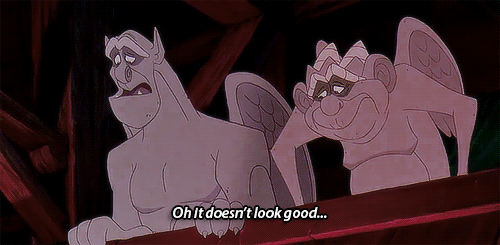
Sadly, after this amazing, epic sequence, we once again are subjected to tonal whiplash when we return to the bell tower and the gargoyles decide to sing Quasimodo a song to cheer him up. Although I maintain Hunchback has one of the best soundtracks ever recorded, what stops it from being flawless is this song. A Guy Like You is not an inherently bad song on its own, but when combined with the rest of the soundtrack, its melody, tone, and out-of-place pop cultural references are just ridiculously jarring. It’s like we’ve been transported into a completely different movie, one less inspired by a classic French novel and a critically acclaimed film about social justice and one more inspired by Disney hits of the day like Aladdin and later projects like Hercules. As sad as it is, it’s kind of a relief when it’s over and we’re brought back down to earth by Esmeralda carrying a close-to-death Phoebus into Quasimodo’s tower.
Frollo’s arrival after Quasimodo agrees to hide Phoebus is excellent in its suspense. We can sense Frollo’s suspicion, and all the while, we’re so worried for Phoebus hiding under the very table he and Quasimodo are sitting at. Then Frollo, who we’ve only ever seen as cold, conniving, and controlled, bursts into a rage the kind of which we’ve never seen before, and for a second, he’s a demon himself. After his rage is spent, he sets his cruelest, most terrible trap yet: using Quasimodo’s feelings for Esmeralda so that he can capture her and the rest of the Romani. And at first, Quasimodo almost doesn’t take the bait, thanks to a short-lived pang of self-pity. At first he’s bitter about his heart being broken and considers not helping Esmeralda, as there’d seemingly be no “reward” in him doing so...but the feeling is quelled in seconds by the memory of Esmeralda and how much her friendship means to him. Quasimodo’s selflessness and goodness wins out in its struggle with his more selfish instincts...and this, in the end, is what makes Quasimodo a hero in my eyes.
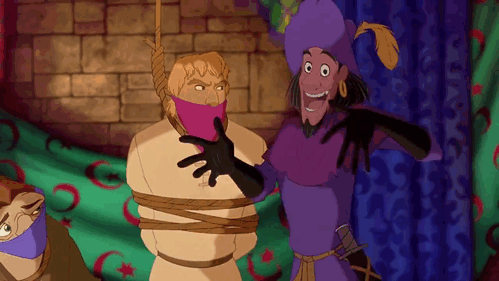
All right, I guess with our entrance into the Court of Miracles, I should address the elephant in the room. I’ve called Esmeralda’s people “the Romani” in this review, but throughout the entire film, the term is substituted for the admittedly-period-appropriate slur “Gypsy.” I knew nothing about the Romani culture when I first saw this film and I profess no intimate knowledge of it now, but even with that, I have to acknowledge that this movie doesn’t always showcase the Romani in the best light. Although Quasimodo’s parents, Esmeralda, and (to a degree) Clopin are given relative sympathy, the sequence in the Court of Miracles doesn’t do much to endear them to the audience. These victims of persecution are not really given the focus they deserve: we never learn much about their culture or about why they’re persecuted, and we don’t really get to see how they live their lives as ordinary people. To someone who doesn’t know anything about the Romani, I don’t think this film would be the best introduction to their culture and heritage.
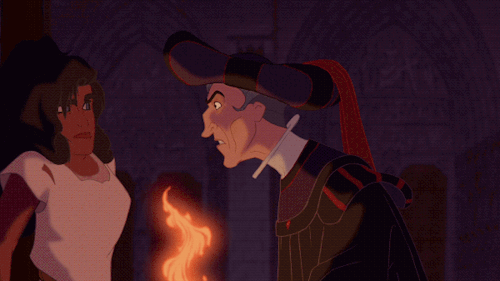
Our climax is accompanied by the best instrumental track in the film, Sanctuary! Whenever I hear this piece, I have to stay completely silent, drinking in every single line and note, so as to properly absorb its brilliance. The track has accompanied a lot of my writing in the past: it’s always helped me when I was writing a powerful, emotional climax, whether through the emotion it wrought from me or just from wanting to write a new scene to the music. This entire sequence, from a musical, writing, animation, and character point of view, is I think what made Disney decide to make this film in the first place. The pacing -- the character animation of Quasimodo tearing down the pillars -- the drawn backgrounds of Notre Dame -- the camera whirling over the never-ending crowd’s heads and up onto the cathedral as Quasimodo hoists Esmeralda over his head -- this is the heart of why the movie was made and what the entire film was building up to. This resistance against injustice and the protection of our sacred, historical institutions from hatred and cruelty is what Hunchback is and should be all about. Occasionally this battle scene is inter-spliced with comic bits that once again aren’t really necessary and kind of stick out (Laverne’s Wizard of Oz reference and Hugo’s impression of a fighter plane in particular are out of place), but it doesn’t ruin anything for me. Fortunately as the climax grows darker with the arrival of Frollo and the transition from Sanctuary! into And He Shall Smite the Wicked, the gargoyles take a backseat, and we get focus where we should’ve always had it: on Quasimodo, Esmeralda, and Frollo. Thanks to his love for his friend Esmeralda and the realization of his own self-worth, Quasimodo finally stands up to Frollo and breaks free of his poisonous influence once and for all. This line of Quasi’s has always stuck with me --
“All my life you’ve taught me the world is a dark, cruel place...but now I see the only thing dark and cruel about it is people like you!”

Even now this line is just so powerful. There was a point where all I saw of the world was its cruelties and injustices...but like Quasimodo, I’ve come to see that those cruelties are not inherent to the world or even to mankind as a whole. Humans are capable of both great evil and great good, but as long as the evil people of the world are allowed to seize control and exert their toxic influence over everyone else, the world and mankind overall will never become better. Like Quasimodo, we must stand against those who’ve embraced cruelty and hatred over acceptance and love. We must protect the brighter parts of the world that evil so wishes to snuff out. It’s a moral I think has only become more relevant and important over time.
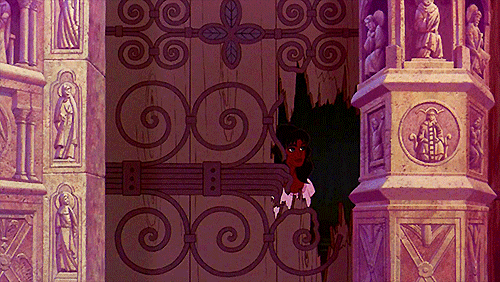
Unlike in the book and musical, Esmeralda survives, and as much as I’ve heard people try to argue Esmeralda living is not true to the spirit of the original novel, I think it really suits the story being told and really feels just for both characters. Quasimodo deserved happiness; Esmeralda deserved happiness; and most importantly, this all the more highlights how different Quasimodo is from Frollo. Frollo says to Esmeralda, “Choose me or the fire” -- basically, if he can’t have her, he doesn’t want anyone else to...but Quasimodo doesn’t think that way. He cherishes Esmeralda and her friendship without any caveats or conditions: therefore him losing Esmeralda, whether to Phoebus or to death, doesn’t prompt him to commit suicide like he did in the novel. It’s not only a more uplifting ending, but I think a lesson in the selflessness of love, even if it’s just platonic love. And because Esmeralda loves Quasimodo just as much as a friend, she leads him out into the sun, where he finds even more of the love he deserves from the city he wished so much to belong in. Quasimodo doesn’t get the girl, but that was never what he wanted in the first place: it was merely to be accepted as he was.
The Hunchback of Notre Dame was one of the most formative films of my childhood, right up there with Beauty and the Beast, The Prince of Egypt, and Anastasia, and it remains my second favorite Disney animated film of all time. With time, I’ve seen more and more of its flaws, but those flaws don’t ruin what in the end is one of the most daring, revolutionary projects Disney Animation has ever tackled. Its artistry, from the backgrounds to the character animation, is exceptional; all of its major human characters are multi-faceted, complex, and real; its themes are eternally relevant and powerful; and its score and nearly all of its songs are just through the stratosphere in their quality. Hunchback, along with Beauty and the Beast, made me fall in love with France from afar as a child, a love affair that has only become more and more intense through the years, and Quasimodo and Esmeralda even now are so close to my heart. I wish so much to be as kind and gentle as Quasimodo and as brave and noble as Esmeralda, and I can only hope that at some point, if I ever visit Disneyland Paris, I might finally meet them. The Hunchback of Notre Dame may not have gotten the appreciation it deserved when it first came to theaters, but I’ll always be happy to hear Disney fans remembering it as fondly as I do. Who knows? Maybe someday, the world will be wiser and will give this film its time in the sun at long last.

#d-views#disney reviews#the hunchback of notre dame#disney#opinion#analysis#reviews#oh boy here i go
16 notes
·
View notes
Text

If the rumors are true that print is dying, then we’re in a zombie apocalypse. Booklr and the self-designated online community of book lovers, as well as publishing professionals and the more dismal-minded of authors, have been predicting the death of print culture for years. Yet it persists, with physical books still outselling e-books by a hugely significant margin. Zine fairs, DIY publishing, and small publishers creating beautiful physical copies are popping up everywhere in my feeds and in the culture, and I’m excited about it. If anything, the intensification of the digital realm has increased the demand--and need--for print publications. They complement each other in ways that no one (or at least, of other non-tech-native generations....no shade dad) could have predicted.

It’s appropriate that the first interview in the series is with the Road Virus, a horror-genre-and-queer-focused mobile bookstore currently traveling the United States. I came across the Road Virus in the digital realm, where we followed each others’ writing. We hit it off right away, because we both have telephone anxiety and have a passion for the non-hierarchical, accessible future of literary culture. Sade and I had a conversation on G-Chat about what it’s like to run a mobile bookstore, Stephen King, accessibility in book culture, how libraries can save lives, and the future of lit. Check it out below:
So first off--thanks so much for your time/agreeing to this interview! I'm super stoked about the Road Virus and everything it's about.
Absolutely, and again––thanks so much for doing this interview project in the first place. I definitely feel like now, more than ever, the world needs a good strong focus on things with a literary bent. The best part is that we're the ones writing, in realtime, the history of our own culture.
Give me your elevator pitch for the Road Virus--except the elevator is broken, so you have more time than you thought.
The Road Virus is a time-tested dream come true. Born out of displeasure with the stasis of ordinary living, my best friend Em and I decided that we wanted to open a bookstore. Books and literature have been in our bloodstreams since before anything else really mattered, so we decided to make that a tangible reality.
Unfortunately, since things in life are so uncertain, opening a brick-and-mortar store just didn't seem feasible. So, we decided on the next best thing––we bought a bus and converted it into a half-RV home, half-mobile bookstore. Lucking out with an ex bookmobile, we decided to focus on fringe genres such as horror, sci-fi, subversive graphic novels and comics, erotica, fantasy, and so on––both due to our limited space and our own inherent interests.
We plan to visit even the most remote parts of the US––and someday beyond––with the concept in mind that a lot of places don't have access to the kind of wares we're totting.
Now, I imagine the elevator creaking, hitching––giving us a fleeting hope––and then plummeting down the shaft. We're probably fine.
------------------------------ keep reading below -------------------------------

How did you and Em meet to form this dynamic duo of traveling booksellers?
We met by the grace of a mutual friend. A night out drinking in one of the darkest and dingiest bars in the world led to a weirdly cohesive and whirlwind friendship. After discovering our shared love and obsession with books and bookstores, we came around to discussing the idea of opening and running our own. We ended up taking a pretty much spur-of-the-moment trip to Tokyo; something about that trip set reality in motion and things ended up happening so fast that I still look back on it and wonder if it wasn't all just a dream.
Is the name the Road Virus inspired by the Stephen King short story?
It certainly is. With our main focus being on horror and all things related, we felt like we needed a name which not only reflected the contents of our shelves, but also our goal.
In the story, the Road Virus is a car owned by an interdimensional killer; it travels across the US, leaving a swath of death and destruction in its wake. Less on the murder-y side for us, we see it as a way of spreading knowledge––which, of course, can be one of the deadliest and most destructive tools of all. The story, which first appeared in the anthology 999––edited by Al Sarrantonio, this book has been one of my most prized possessions since childhood––has always stood out to me; when we were kicking around ideas for names, The Road Virus was one of the first I jotted down. It came back, and it stuck.
Also, when I saw that your name was the Road Virus, I couldn't help but connect the resilience of the killer painting in the story with what you both are doing for print literature---in a positive, not at all murderous way--that bookstores are closing down, and people proclaim that print lit is dying, but the Road Virus is an active example of print literature's resilience against all odds. With that in mind---what would you say to people who claim that print lit is dying? and what pushed you to start the Road Virus at this moment in time?
I really enjoy the emphasis we're both putting on this totally not being a murder thing at all, whatsoever.
To those who say that print lit is dying, that books are obsolete, that the internet is the only way to acquire new information and fiction, I say: barring the physical process of a body shutting down and decomposing, something can only truly die if you allow it to. As long as there is at least one person publishing a book or zine and one person reading it, the concepts and idealism and spirit of print lit will survive and thrive.

Yes! It's so important to me that you connect physical, print lit with physical bodies. The power of print literature is that it creates physical community in a way that digital can't do alone. And physically showing up for something you care about can, and will, keep it alive.
Absolutely. Something that people need to remember now more than ever is that we have the ability to influence anything and everything. There is always a light in the dark, and we always have the choice to make something of ourselves and our surroundings. We are not powerless. For people like us, books have always been an escape, but they're also so much more: calling cards, symbols of power, beacons of hope tying groups together and ripping old systems apart.
Literacy is an extremely important thing to both of us––Em, as you said, is a former librarian, and I myself basically learned all I know from books. Libraries and bookstores were like second homes to us as kids––and sometimes, more so a first home to me personally. I dropped out of school at a very early age and attribute the majority of my ability to comprehend the world around me to the free, open-access presence of libraries. I come from a non-academic background, and Em comes from one of thorough education-oriented leanings; this combination suits us to a t.
The idea that they're dying out and being defunded saddens us greatly, and we feel the need to bring back those concepts to the forefront.
Mutually, we wanted this to be a bookselling venture so that we can sustain ourselves through the trade itself; however, we definitely felt the need to interweave the free and open-source aspect of libraries. We're still working out the avenues of providing reading lessons, and have quite a few ideas in mind for things like free movie nights and author readings.
What's being on the road like? Where have you been, and do you have any weird stories/interesting encounters?
Living in San Francisco, we've been very fortunate to have some amazing haunts. I think we owe a lot of our inspiration for The Road Virus to our favorite daily stop, Aardvark Books on the historic Church St.
Actually, we've been drydocked, so to speak. Our goodly vessel has been parked at a friend's about an hour northeast of SF for over a month now; we've been living on the bus full time while we've been renovating and preparing for permanent life on the road. We also unfortunately ran into some issues with the electrical system, which is being taken care of this week.
Regardless, we're both pretty nomadic people, and we can't wait to officially take off. I can say that driving the bus back to the buildsite was a hell of a trip.
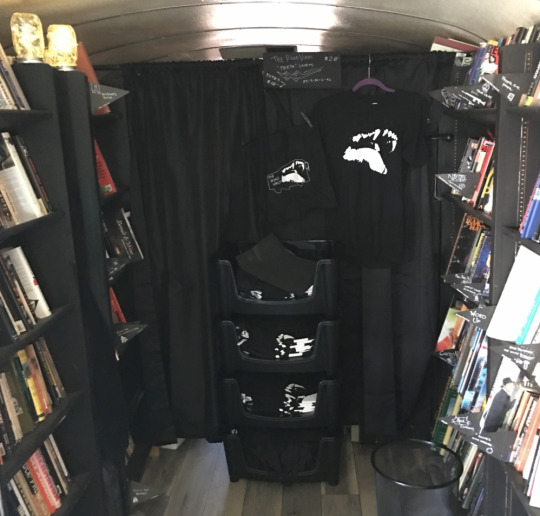
Before we got her, Jolene––our name for the bus––lived a quiet life in Kansas City, MO. We flew in and were planning on driving her back in 2-3 days. This, as it turned out, was absolutely impossible. It ended up taking a week, and was rife with complications; we broke down numerous times, ended up sleeping in the uninsulated bus in -20 degree weather, and had endless scares on the road. Driving through the midwest was like traveling through a different world. I don't think I've been stared at that much in my entire life, except maybe in Tokyo (I'm covered in tattoos, piercings, etc.).
The drive back over the CA state line was like something out of a dream––more a nightmare, maybe. We drove into one of the worst rainstorms I think I've ever seen, to the point where cars were sliding all over the road, trucks were going 20mph on the highway, and vehicles our size were actually barred from driving any farther at a certain point, so we were all lined up on the side of the highway for hours. This was on about 36 hours of no sleep. As far as fun stories on the road, in my experience they are many and not-so-far in between; we'll have plenty to share once we really get going, I'm sure. Driving through the snow-covered Rockies in a 32' bus when neither of us had driven anything larger than a UHAUL truck was certainly one for the books.
Lastly, in a quick semi-tweet-length: How do envision the future of literature?
Futurelit, the Tweetening: Though ink may run, pages may yellow, & screens may flicker–the world of lit will forever reinvent itself, thriving in the face of adversity.
xxxxxxxxx
Follow the Road Virus everywhere:
(Facebook, Tumblr, Twitter, Instagram, and Snapchat) @roadvirusbus
Communicables: http://theroadvirus.com/blog
Reading Is Infectious (book subscription service) (http://shop.theroadvirus.com). A book in the genre of your choice delivered to your door every month.
#the road virus#road virus bus#booklust#futurelit#lit#interview#horror#queer#bookmobile#publishing#jolene#public libraries#zombies#booklr#spilled ink
29 notes
·
View notes
Text
First Nations Tribes Matter Too.
After spellbinding the readers by his fabulous imagination in Screamcatcher: Web World, Chris Stevenson, who writes this series by a pen name (Christy J. Breedlove), released the second book of the Scremcatcher series, Screamcatcher – Dream Chasers. Both the books of the Screamcatcher series have created an alternate world that leaves the characters and the readers gasping for air. So, when I got a chance to pick the brains of the very talented Chris Stevenson, I knew it was an opportunity of a lifetime. Join the conversation and get ready to be amazed.
Screamcatcher is one of my favorite series. Nobody could have ever imagined using an innocent-looking dream-catcher as a source of unleashing havoc. How did you come up with this idea? Any interesting story behind the making of this mind-blowing series.
It all started with a dream catcher. This iconic item, which is rightfully ingrained in Indian lore, is a dream symbol respected by the culture that created it. It is mystifying, an enigma that that prods the imagination. Legends about the dream catcher are passed down from multiple tribes. There are variations, but the one fact that can be agreed upon is that it is a nightmare entrapment device, designed to sift through evil thoughts and images and only allow pleasant and peaceful dreams to enter into the consciousness of the sleeper.
I wondered what would happen to a very ancient dream catcher that was topped off with dreams and nightmares. What if the nightmares became too sick or deathly? What if the web strings could not hold any more visions? Would the dream catcher melt, burst, vanish, implode? I reasoned that something would have to give if too much evil was allowed to congregate inside of its structure. I found nothing on the Internet that offered a solution to this problem—I might have missed a relevant story, but nothing stood out to me. Stephen King had a story called Dream Catcher, but I found nothing in it that was similar to what I had in mind. So I took it upon myself to answer such a burning question.
Like too much death on a battlefield could inundate the immediate location with lost and angry spirits, so could a dream catcher hold no more of its fill of sheer terror without morphing into something else, or opening up a lost and forbidden existence. What would it be like to be caught up in another world inside the webs of a dream catcher, and how would you get out? What would this world look like? How could it be navigated? What was the source of the exit, and what was inside of it that threatened your existence? Screamcatcher: Web World, the first in the series, was my answer. I can only hope that I have done it justice.
Your knowledge of Native American Indian culture is evident in many instances. I am sure the readers would love to know more about the subject. How do you know so much about the culture? Is it personal experience or an inclination toward the culture?
It’s primarily researched, and not very much. I’ve always known about the emotional feelings that the First Nations Tribes has/had about their plight and contact with the white man. I knew about their reverent association with nature and the environment. I owe a lot of it to memories from the Boy Scouts of America–about signs, riddles, plants, hunting, and the environment. I’m Scotch/Irish and I’ve never had any tribal friends.
I DID research the construction of the Dream Catcher and what it was made out of. I winged the rest of it, hoping that I was at least on target with what I had to say about them. The Albert White Feather Pike speech at the beginning of the book (about the sad state of the world) were my words straight from my heart. Nothing was quoted. I did not want to ram Indian lore, heritage, and legend down the throat of the reader. There’s just enough to make it sympathetic and interesting.
While we are talking about Native American culture, do you have a favorite legend from any of their mythologies?
Obviously, the Dream Catcher Legend. It was just fascinating to me, filled with whimsy and magic. And the hand-crafted charms are so varied from one type to another; they are just gorgeous works of art, and I mean that by saying the originals that were crafted in the very beginning with gems, beads, and real Eagle feathers. And I’ll be honest, I have NO idea how far the Dream Catcher legend goes back in time. I’m also intrigued by the sweat lodge, and how it is supposed to purify the soul. The legend of the Skinwalker scares me, and I touch upon that just a tiny bit in the last book, Screamcatcher: The Shimmering Eye.
You can remove this question if you do not wish to discuss your pen name This one is for budding authors. Many of the first time authors struggle with the idea of using a pen name. While a majority considers using one only if they are writing a memoir and do not wish to be identified, a few others wish to use one to avoid prejudices based on gender or nationality. Regardless of their reasons, what is your opinion on using a pen name? Is there a formal procedure involved in registering a pen name against your legal name?
I’m a guy and I used a female pen name for my young adult books. I know, pretty strange. Why? Women, I believe, are more prone to writing about true emotions, with truth and accuracy, than men. Especially in romance and young adult, where sometimes a softer touch is needed. Women comprise 65% of all book purchases and they are also the majority of readers. Truly, women are more apt to buy a romance or young adult novel from a woman, in my experience. So I thought that if the “general reading public” saw a female pen name, they might make a spontaneous buy and trust the material. But I always admitted everywhere that the two authors were one and the same–Me. My fans, friends, and readership knew that.
The problem with adopting a pen name is that you have a brand new author out there making a debut, so it is hugely difficult to build a readership in that pen name. No legal problems, not even in contracts. But I must say that two author names have to be merged into one in places like Amazon, GoodReads, and other sites–it gets really tangled and confusing. For budding writers? If you are publishing 10 or more books per year and one genre is romance and the other is science fiction, then two authors just might work. It also depends on how many genres you write in and how many books you have out there. My advice is to go with one name–keep it simple just starting out.
Did you always want to be an author? How did you get into it?
I actually started late, reading, and writing when I was 26 years old. My early writing accomplishment were multiple hits within a few years: In my first year of writing back in 1987, I wrote three SF short stories that were accepted by major slick magazines which qualified me for the Science Fiction Writers of America, and at the same time achieved a Finalist award in the L. Ron Hubbard Writers of the Future Contest. This recognition garnered me a top gun SF agent at the time, Richard Curtis Associates. My first novel went to John Badham (Director) and the Producers, the Cohen Brothers. It was an extreme honor to be considered. The writer who beat me out of contention for a feature movie (as well as the book), was Michael Crichton’snJurassic Park. My book was called Dinothon.
A year after that I published two best-selling non-fiction books and landed on radio, TV, in every library in the U.S., and hundreds of newspapers. This was at a time when small and mid-sized press paid nice advances and had unlimited distribution.
I have been trying to catch that lightning in a bottle ever since. My YA dystopian novel, The Girl They Sold to the Moon won the grand prize in a publisher’s YA novel writing contest, went to a small auction, and got tagged for a film option. My latest release, Screamcatcher: Web World, just currently won Best YA title of 2019 in the N.N. Light Book Awards contest. I have 13 titles appearing on Amazon, with three more slated for publication. I guess I should stick to Young Adult, which I do love BTW
I have picked out your next book Earth Angel, and I am pretty excited about reading it. Would you like to share anything about the book: plot, character, inspiration?
Not much to tell really, and it’s not terribly original, but I’m guessing at that. I just wondered what would happen if a person had an eye transplant, and that eye came from a gifted medium who really saw a fourth dimension or alternate world through her vision? If that transplanted eye allowed you to see a different world, what in the heck could you possibly see and how would it affect you emotionally? You would either have a superpower, or you would end up going insane. How could a power like that possibly help you in catching a serial killer? Those were the questions I asked. Hey, glad you are looking forward to it!
Who is your favorite character in Screamcatcher series? Did any real-life person inspire this particular character?
My favorite character, modeled in name and personality after my sister, Jory Post, is Jory Pike. Jory Pike’s physical attributes are modeled after my last girlfriend in Las Vegas. I had many reviewers and some beta readers tell me, “Hey! You have Katniss here, in The Hunger Games!” I did not know who they were talking about until I just recently read the THG series. Then I thought, OMG! My girl is Katness!
And to top it off, I wrote my book before The Hunger Games came out, but mine was not published before hers. My gal IS native American, though. And I’m proud that the female side of me came out with an Indian teenage girl who takes the lead in a portal fantasy thriller. Rarely, if ever, do you see teenage, female North American Indians in a book, especially in the lead role. Talk about POC (people of color), well, I thought I’d give it to them in spades.
May we get a sneak peek into your next WIP?
The third and last book in the Screamcatcher series (The Shimmering Eye) is modeled after the true story of the most haunted property in the United States–Skinwalker Ranch. I devised my own version of the paranormal activity out there, and even contacted George Knapp, an investigative reporter out of Las Vegas, and host of Coast to Coast radio. I asked his permission to write my own fictional account of such a place, without busting his copyright or anything else. He is the documentary narrator and book author of The Hunt for the Skinwalker. George gave me the thumbs up and wished me well. So I tossed my teenage Badlands Paranormal Society into the ranch and brought hell and damnation down on them. The third book in the Screamcatcher series will be out sometime this summer.
Thank you so much for answering the questions. Can’t wait to see more of your work soon!
More places where you can find Chris Stevenson:
Amazon Page: https://www.amazon.com/Chris-Harold-Stevenson/e/B001K8UUBK
Christy’s Website: https://christysyoungadultfabuliers.com/
Blog: http://guerrillawarfareforwriters.blogspot.com/
0 notes